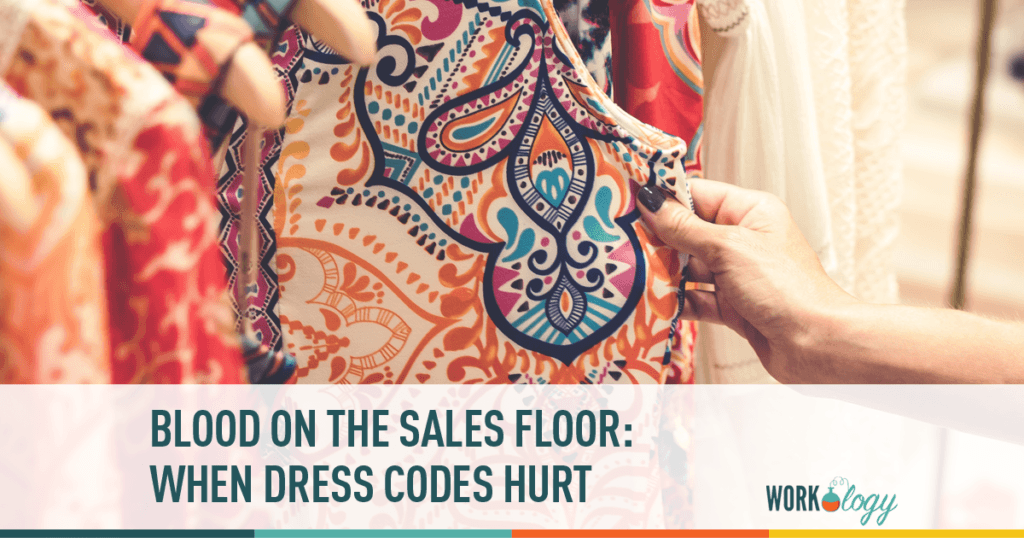A waitress at a Joey Restaurant in Edmonton, Alberta says she was forced to work in high heels despite their causing injury to her feet. Human Resources Online reported that, according to a friend’s Facebook post, the woman was told by her manager that heels were a required part of the dress code and exceptions would only be made on a medical basis — presumably with a doctor’s note. After changing into flats when her heels rubbed her feet raw and bloody, the woman was disciplined by her manager and told heels would be required for her next shift.
Nicola Gavins, a friend of the waitress, shared the story on her Facebook:
Are heels in fact part of Joey’s dress code? It turns out that yes, they are the preferred option for female staff members but dress flats are an option.
In March, after another controversy over restaurant dress codes and a subsequent report by the CBC investigative television show Marketplace, Britt Innes, Joey Restaurant Group VP of Marketing, told CBC that
“With respect to footwear, we want our employee partners to wear a shoe that provides arch support. We have worked with a podiatrist to determine the height of shoe our employee partners can comfortably wear. As a result, our dress guideline is for shoes of ½” to a maximum of 3” in height. Our employee partners choose what is comfortable for them and if they are unable to wear a ½” heel, they wear flat dress shoes. The manager you spoke with was misinformed about heel height and we will be following up with our team to ensure our guidelines are followed. If we see a heel higher than 3”, we will ask our employee partner to change.
In fact, we recently took the unusual step of partnering with a podiatrist to design and develop a shoe that provides the ideal arch support for our employee partners. We then tested that shoe in our test stores and asked employee partners for feedback. The feedback was that they disliked the look of the shoe and wanted to continue wearing their own footwear. While we ultimately decided to allow our employee partners to pick a shoe that they are comfortable in (as long as it is no higher than 3″), the project was a valuable exercise in understanding the preferences of our employee partners.”
While it’s encouraging to learn that Joey takes employee comfort so seriously, their corporate dress code policies — and those of other restaurant and retail groups — don’t seem to be in full effect on the ground floor. Dress code conflicts and incidents of discrimination in the restaurant and retail industries are incredibly common. So much so that I usually decline to report on all but the most egregious cases, because otherwise I’d be reporting on waitresses told to wear thongs and hike up their skirts, cashiers and salespeople told to wear more makeup, and black women fired for natural hair — every week.
Wearing the Brand
In service industries like retail and the restaurant business, dress codes are a marketing and branding opportunity. Not only can you put branding on your employees in the form of logos, but your employees can model the brand through prescribed dress, hair and makeup. Along with prescribed postures, expressions of emotion and scripts, this is how employees represent the brand: they wear it, they perform it and they embody it. And while that’s great for the brand, if these policies aren’t designed with employee comfort and safety in mind, they can be harmful.
High heels are a common source of workplace injuries. Short skirts can make women feel uncomfortable and objectified. Strict policies on hair and makeup designed with white women in mind penalize women of colour. Intensive scripts and policies around performance can become heavy emotional labour, leaving employees feeling like robots or vulnerable to customer abuse. Remember the Starbucks “talk about race” campaign? That’s just one example of employees being expected to do and feel too much — especially for the wage they take in.
To no one’s surprise, bad dress code policies hurt women — especially women of colour — more than they do men. Almost every example of recent dress code conflicts and scandals involves female employees. The vast majority of them involve what employees felt was compulsory and inappropriate sexualization, leading or contributing to harassment, hostile workplaces and even customer and employer abuse.
While service industry employers have every right to require brand-appropriate uniforms, when the dress code hurts the employee, it also hurts the brand. Dress codes must be fair and non-discriminatory and managers and line supervisors must be trained on the details and spirit of the code. Joey Restaurant Group’s dress code allows employees to choose flats over heels, but the common practice of individual restaurants and stores can often have more weight in day-to-day decisions than corporate policy. In big retail and restaurant chains company culture is a blend of corporate and local — organizations wanting to make positive changes have to take that into account and ensure training at every management level, not just the top.
Every public conflict and scandal is a PR crisis, of course, but unhappy — and even worse, abused or injured– employees have a subtler negative effect on the brand. A bad dress code makes a company a bad place to work; and if the story takes off, a bad place to eat or shop, too.








